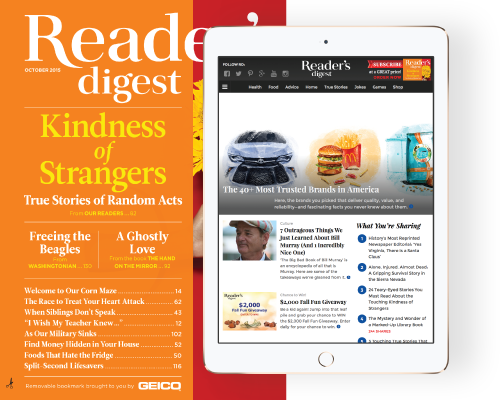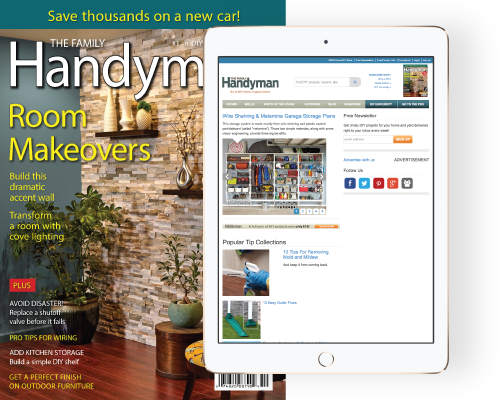Digesting the future
Vince is one of 60 speakers confirmed for the 41st FIPP World Congress, taking place from 9-11 October 2017 in London. See more at fippcongress.com.
Your brands have traditionally had a very strong print and direct marketing approach. How is that changing in the digital world and how are you managing that transformation?
I’ve been at TMBI a little over a year at this point and I would say there are probably a handful of things we’re looking at which are innovative for the industry. Our brands are multigenerational, so when you look at brands like Reader’s Digest or Taste of Home – or even The Family Handyman for that matter – what we’re seeing is that our content and our community are creating cross-generational links. So on Taste of Home you will have a grandmother, a daughter and a granddaughter all participating through various aspects of the brand and possibly different media types. The grandmother may not be online; she may be subscribing to the magazine, but her recipe might be online because she’s submitted it and it ended up in our print magazine. The daughter is then online commenting on the recipe saying, “oh, this was always our favourite recipe,” and the granddaughter is participating by further sharing it with her friends on social media. Or sometimes the mother and the daughter will go to a Taste of Home Live event together. Sometimes they’ll even bring the grandmother with them. So we’ve really created ways for our users to interact with us in any medium they choose, and this is true with Reader’s Digest as well. A millennial remembers seeing the magazine in their grandparents’ or parents’ home and now they’re interacting with a familiar brand online. I think that is unique for our brands.

Does that mean you are putting a strong focus on consumption habits for different audiences – and making sure you serve those?
That’s exactly right. What we see with some of our print subscribers – to Reader’s Digest, for example – is those who skew on the older side visit our website very, very little. With the Reader’s Digest brand in particular, we also see when our digital readers reach a certain life stage – let’s say they are in their 30’s and they’re having children – they then start interacting with the brand differently. They start subscribing to the magazine because it’s safe material to have lying around the home. Anyone can look at it – their grandparents can come over and look at it but their children can also pick it up and they know it will be safe. And so, yes, we’re absolutely trying to make sure we’re catering to all of the ways people want to interact with us and also creating those links across the different ways people want to read our content.

That’s equally true as we expand our digital presence. As our digital footprint grows, we are attracting new audiences to our brands. We’re also attracting younger audiences who might already know the brand, but hadn’t been aware that the content is available online. Understanding and catering to those different consumption habits, wherever someone wants to interact with us, are key drivers of growth.
How is digital helping with the acquisition of audiences, in addition to serving and retaining existing audiences?
I recently brought on a new VP of digital content strategy and audience development, and this is her main area of focus. Based on comScore results, we’ve had phenomenal growth in our unique visitor numbers across all of our properties over the past year. But probably the most pronounced growth has been in Reader’s Digest and The Family Handyman. What’s interesting about this growth is that leveraging newer digital platforms is working for us in attracting new audiences.
To reach those audiences through content that traditionally has really only been available in print, and then bringing it online and finding it actually resonates with a larger audience and a younger audience, is brilliant. Anywhere between 30-40 per cent of our visitors are now millennials. And that bolsters our multi-generational appeal.

Special interest titles have always benefited from very strong audience loyalty. But how do you make sure you continue obtaining new audiences?
I think what’s interesting for us is that the value proposition of our brands has stayed constant and steady over time, and that value proposition is still relevant to today’s readers. I would actually say that given the big announcement P&G made recently about greater transparency in digital media, our brands may be even more relevant. We have always provided that transparency and that brand-safe environment in our titles, whether in print or online. We have what we call a well-lit environment. People can feel safe, whether they’re in our magazines or on our sites, and that’s always been part of our brand proposition. It’s always been important to our readers and our advertisers. Now, with the P&G announcement, it has renewed relevance to our advertisers.
Related: Google’s ad placement headache (and why publishers may feel a touch of schadenfreude)
This refreshed relevancy has also made our content and our brands more discoverable for online enthusiasts. Our digital initiatives have helped enthusiasts discover other relevant content as well, which is driving new audiences to our sites, particularly those most interested in the content areas we cover. So far, these audiences are proving to be as loyal as our current audience.
How are digital and social opportunities helping with your revenue model?
There are two main ways digital, in general, and social, in particular, are helping with our revenue model. First, digital is allowing us to cast a larger net allowing our brands to be discovered by more people who are interested in our content. Many of those people become new magazine subscribers, which is still an important source of revenue for the company. Secondly, once someone has discovered our brands digitally, they often follow us on social media, which drives repeat return visits to our sites to read more. That drives digital advertising revenue, which is another important and growing source of income for the company.
Get stories like these delivered every week into your inbox. Subscribe to our (free) FIPP World newsletter.
Where does a brand such as Reader’s Digest go from here? What are the opportunities and the innovations you are excited about?
When I got here, all of our digital content was coming downstream to us from the print product. So in any given month we would get anywhere between 40 to 60 pieces of content directly from the magazine. We weren’t able to put all of that online for a variety of reasons, but we would add whatever we could. In the past year, we’ve really changed that model and looked at what content areas resonate with our audience and which content areas people want us to explore deeper. In putting together any kind of print magazine, for every article that goes to print there are probably ten that don’t make it – but which are perfectly good articles. Or there are interesting angles that can be further expanded upon, but not with limited print space. So we have looked at taking some of that additional content and expanding on those areas in digital – in ways that we just can’t do in print. In short, it’s about being able to expand our overall digital content footprint in ways that make sense, without going too broad or away from our core value proposition.
The second thing is around doing more with the communities that we have online. For Reader’s Digest in particular, which has been around for almost 100 years and has historically always gotten massive amounts of reader input – taking the form of letters, stories or jokes they’ve written – online communities can offer a valuable way for users to engage and interact, not just with us, but also with each other. It’s about figuring out how to harness that desire digitally. We still get lots of letters in through the postal system, but we get even more through our digital channels, whether it’s through email or commenting on our social media pages. And we still get lots of submissions of jokes and stories. We are really getting our arms around how we harness that community and fan base to connect them more closely to the brand digitally and with each other – because they do want to connect to each other as well.

Join Vince at the 41st FIPP World Congress, taking place from 9-11 October 2017 in London. See more at fippcongress.com.
More like this
Meet NASA smarts at the 41st FIPP World Congress
[Congress speaker Q&A] ‘Experiment with VR, but the bigger opportunity is AR’
FIPP World Congress 2017 | Meet the speaker: Michael Brunt, The Economist
FIPP World Congress 2017 | Meet the speaker: Shadi Rahimi, AJ+
FIPP World Congress 2017 | Meet the speaker: Wolfgang Blau, Condé Nast International
FIPP World Congress 2017 | Meet the speaker: Yulia Boyle, National Geographic









